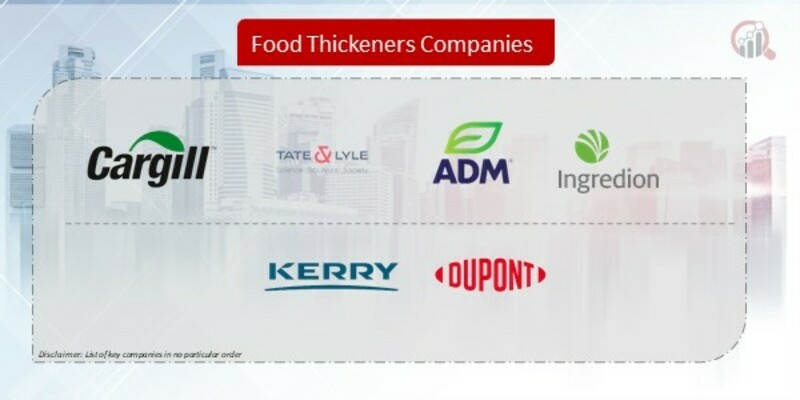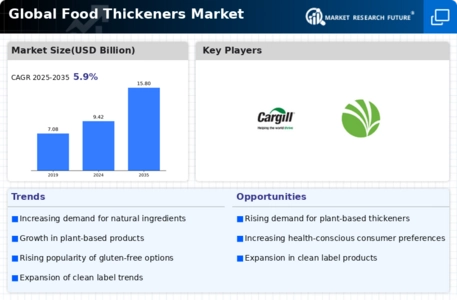Top Industry Leaders in the Food Thickeners Market

Strategies Adopted by Food Thickeners Key Players
The food thickeners market is experiencing significant growth as the food and beverage industry adapts to changing consumer preferences and demands. This analysis delves into the key players, strategies adopted, market share determinants, news, emerging companies, industry trends, current investment trends, and recent developments in 2023.
Key Players:
The food thickeners market is marked by the presence of key players that play pivotal roles in shaping the industry landscape. These key players include:
Cargill (U.S.)
Tate & Lyle PLC (U.K.)
Archer Daniels Midland (U.S.)
Ingredion Incorporated (U.S.)
du Pont de Nemours & Company (U.S.)
Kerry Group Plc (Ireland)
TIC Gums (U.S.)
Companies in the food thickeners market employ diverse strategies to gain a competitive edge and navigate the evolving market dynamics:
- Product Diversification: Key players focus on diversifying their product portfolios to meet the demands of a broad range of applications, including bakery, confectionery, sauces, and beverages.
- Research and Development: Continuous investment in research and development is crucial for developing innovative food thickening solutions that address the evolving needs of the food and beverage industry.
- Strategic Partnerships: Companies often form strategic partnerships with food manufacturers and processors to ensure a steady market presence and distribution channels.
- Geographical Expansion: The expansion into new geographic regions is a common strategy, allowing companies to tap into emerging markets and broaden their customer base.
Market Share Analysis:
Several factors influence the market share dynamics in the food thickeners market:
- Functionality and Versatility: The ability of a food thickener to provide multiple functionalities, such as stabilizing, emulsifying, and texturizing, contributes significantly to market share.
- Clean-Label Demand: With the increasing consumer preference for clean-label products, companies focusing on natural and clean-label food thickeners gain a competitive advantage.
- Supply Chain Efficiency: Efficient supply chain management ensures timely delivery of food thickeners, positively impacting market share through customer satisfaction.
- Regulatory Compliance: Companies adhering to regulatory standards and certifications gain consumer trust, contributing to a positive market share.
News & Emerging Companies:
Recent developments and emerging companies in the food thickeners market reflect ongoing trends and potential shifts:
- Rise of Clean-Label Thickeners: There is a notable trend of emerging companies focusing on developing clean-label thickeners, addressing consumer concerns about artificial additives.
- Natural Sourcing Practices: Companies are increasingly investing in natural sourcing practices for thickeners, aligning with the growing demand for plant-based and natural ingredients.
Industry Trends:
Investment trends within the food thickeners market highlight a commitment to sustainability, innovation, and addressing evolving consumer needs:
- Sustainability Initiatives: Companies are investing in sustainable sourcing practices for raw materials, including responsibly sourced hydrocolloids, contributing to environmental and ethical considerations.
- Technological Advancements: Investment in advanced processing technologies for thickeners ensures improved functionality and meets the diverse needs of food manufacturers.
Competitive Scenario:
The food thickeners market remains highly competitive, with key players leveraging their global presence, product innovation capabilities, and sustainable practices to maintain and enhance their market positions. The increasing interest from emerging companies adds dynamism to the competitive landscape.
Recent Development
A significant development in 2023 is the heightened focus on clean-label thickeners, with key players investing in research and development to meet the growing demand for natural and transparent ingredient lists. This development reflects the industry's commitment to addressing consumer preferences for simpler and healthier food formulations.










